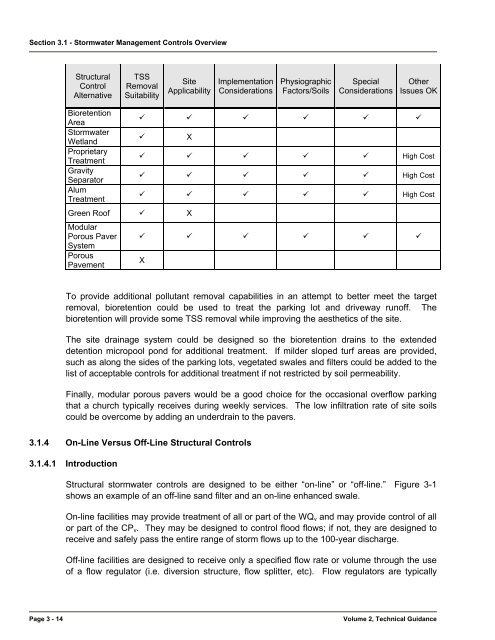Volume 2-05, Chapter 3 - City of Wichita
Volume 2-05, Chapter 3 - City of Wichita
Volume 2-05, Chapter 3 - City of Wichita
You also want an ePaper? Increase the reach of your titles
YUMPU automatically turns print PDFs into web optimized ePapers that Google loves.
Section 3.1 - Stormwater Management Controls Overview<br />
Structural<br />
Control<br />
Alternative<br />
TSS<br />
Removal<br />
Suitability<br />
Site<br />
Applicability<br />
Implementation<br />
Considerations<br />
Physiographic<br />
Factors/Soils<br />
Special<br />
Considerations<br />
Other<br />
Issues OK<br />
Bioretention<br />
Area<br />
Stormwater<br />
Wetland<br />
Proprietary<br />
Treatment<br />
Gravity<br />
Separator<br />
Alum<br />
Treatment<br />
<br />
<br />
Green Ro<strong>of</strong> X<br />
Modular<br />
Porous Paver<br />
System<br />
Porous<br />
Pavement<br />
X<br />
High Cost<br />
High Cost<br />
High Cost<br />
<br />
X<br />
To provide additional pollutant removal capabilities in an attempt to better meet the target<br />
removal, bioretention could be used to treat the parking lot and driveway run<strong>of</strong>f. The<br />
bioretention will provide some TSS removal while improving the aesthetics <strong>of</strong> the site.<br />
The site drainage system could be designed so the bioretention drains to the extended<br />
detention micropool pond for additional treatment. If milder sloped turf areas are provided,<br />
such as along the sides <strong>of</strong> the parking lots, vegetated swales and filters could be added to the<br />
list <strong>of</strong> acceptable controls for additional treatment if not restricted by soil permeability.<br />
Finally, modular porous pavers would be a good choice for the occasional overflow parking<br />
that a church typically receives during weekly services. The low infiltration rate <strong>of</strong> site soils<br />
could be overcome by adding an underdrain to the pavers.<br />
3.1.4 On-Line Versus Off-Line Structural Controls<br />
3.1.4.1 Introduction<br />
Structural stormwater controls are designed to be either “on-line” or “<strong>of</strong>f-line.” Figure 3-1<br />
shows an example <strong>of</strong> an <strong>of</strong>f-line sand filter and an on-line enhanced swale.<br />
On-line facilities may provide treatment <strong>of</strong> all or part <strong>of</strong> the WQ v and may provide control <strong>of</strong> all<br />
or part <strong>of</strong> the CP v . They may be designed to control flood flows; if not, they are designed to<br />
receive and safely pass the entire range <strong>of</strong> storm flows up to the 100-year discharge.<br />
Off-line facilities are designed to receive only a specified flow rate or volume through the use<br />
<strong>of</strong> a flow regulator (i.e. diversion structure, flow splitter, etc). Flow regulators are typically<br />
Page 3 - 14<br />
<strong>Volume</strong> 2, Technical Guidance
















